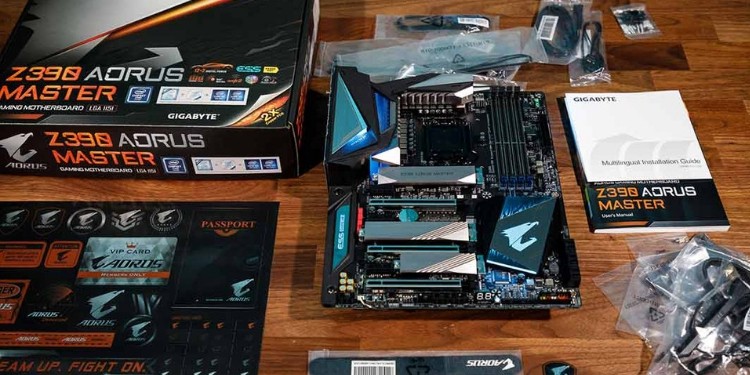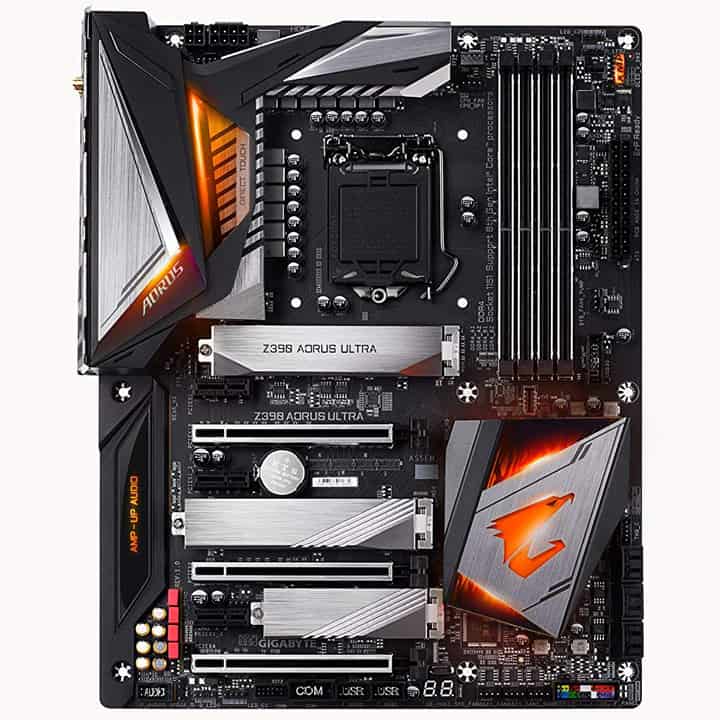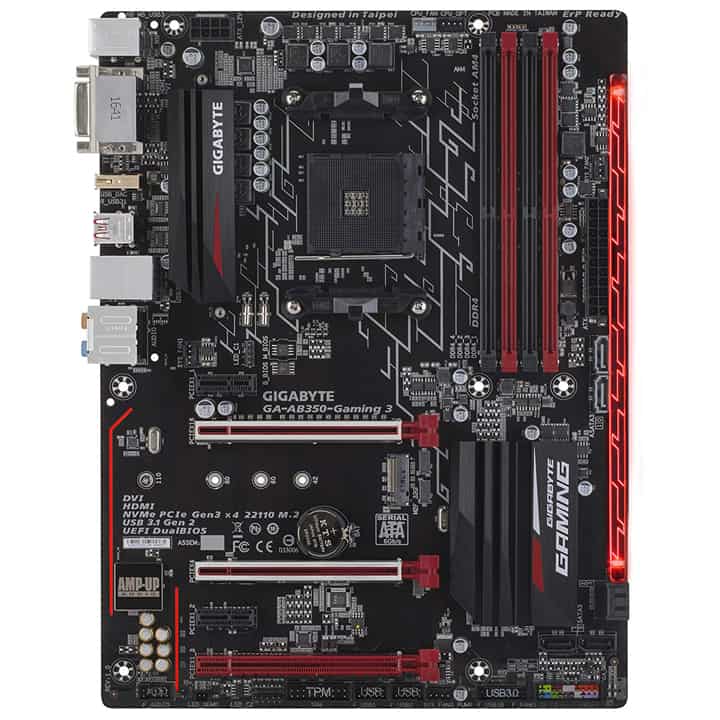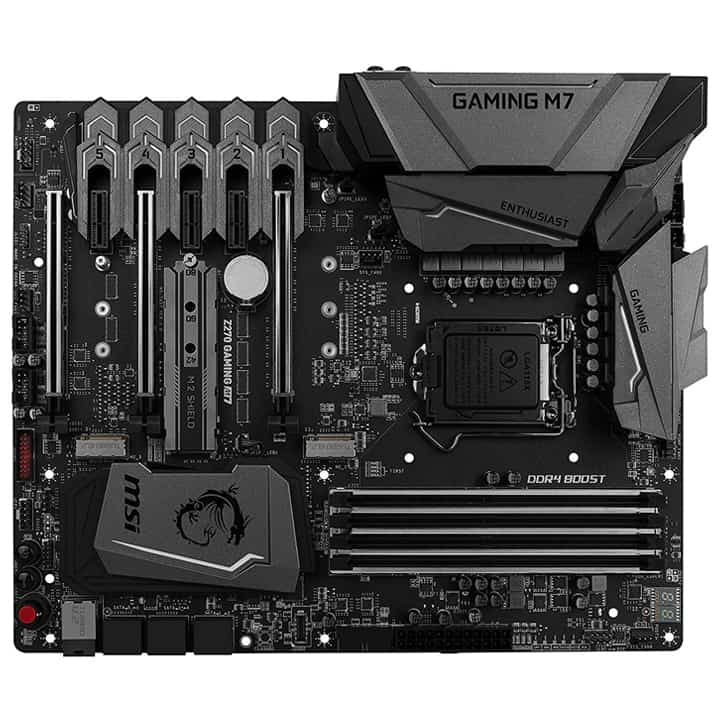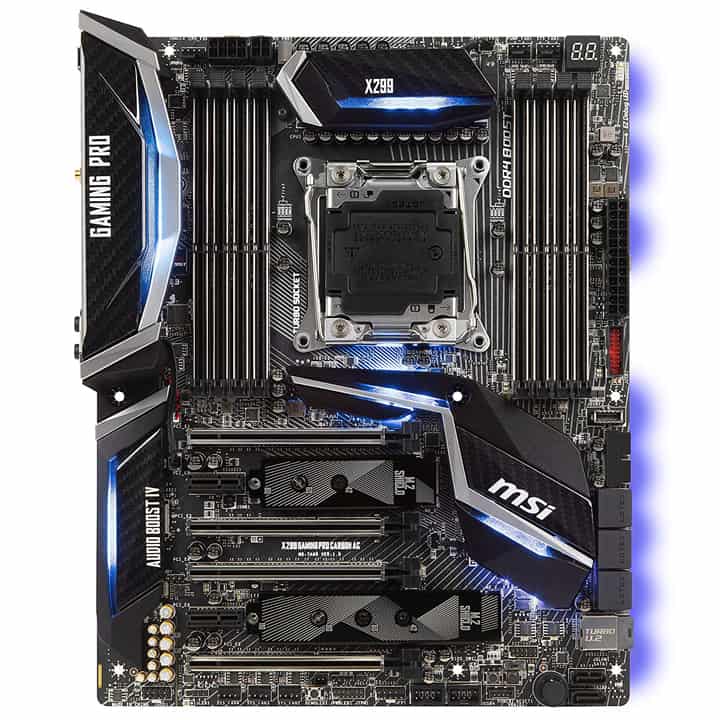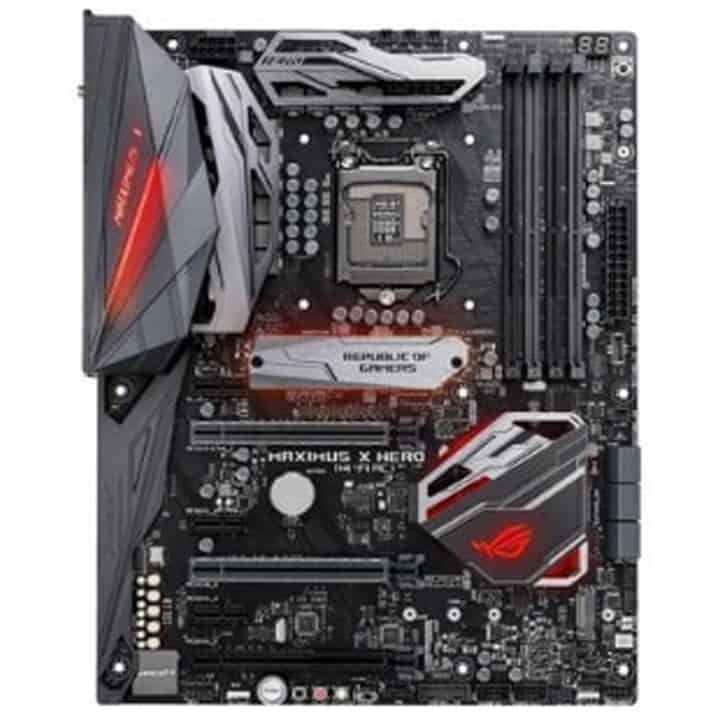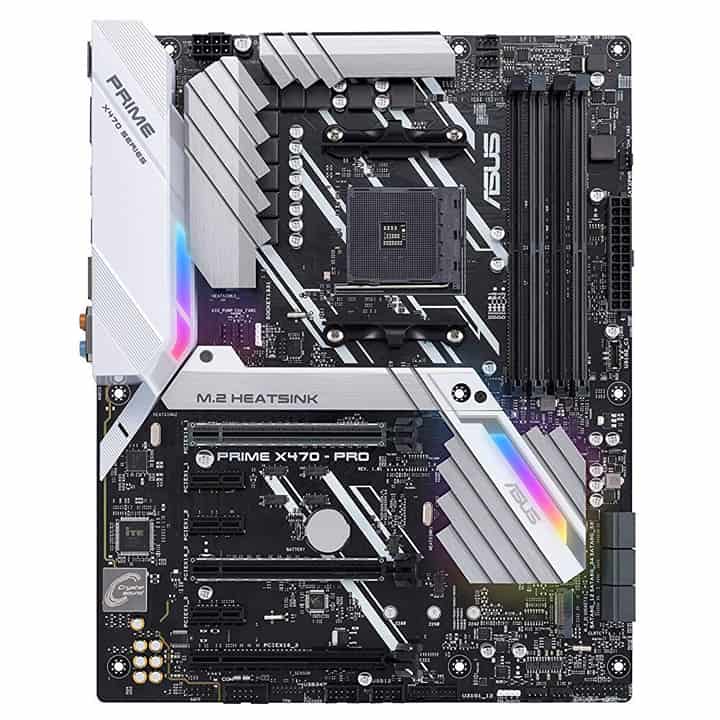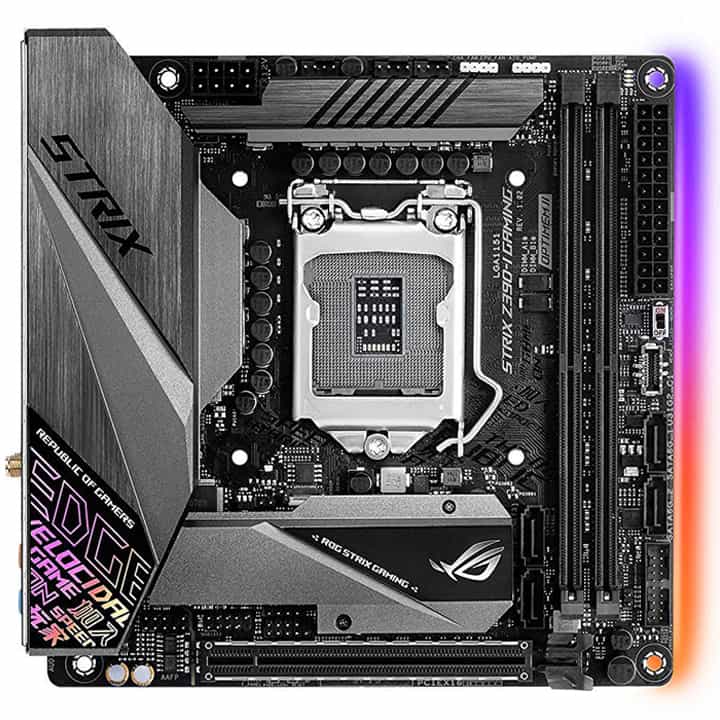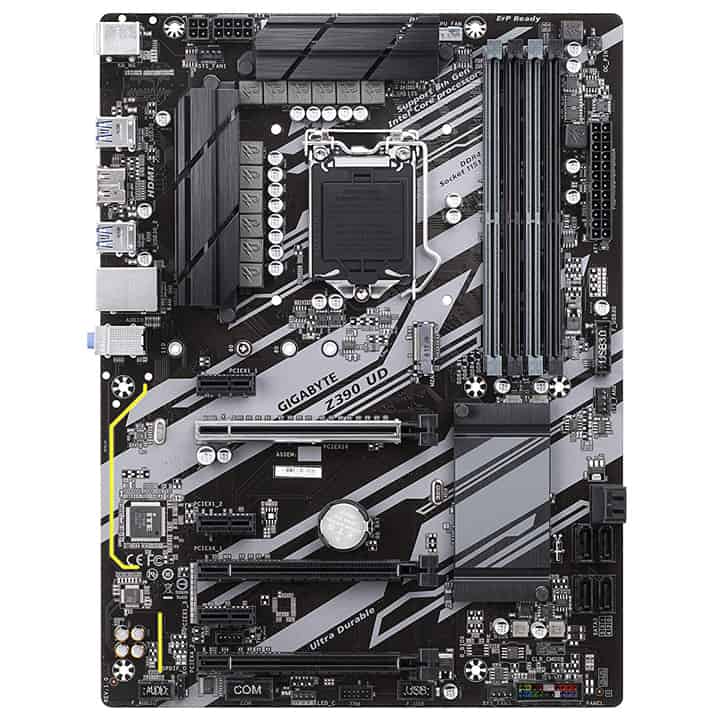When it comes to building a great gaming computer, the importance of choosing the right motherboard cannot be overstated.
The motherboard is the glue that holds your rig together. It determines the amount and speed of RAM you can use and the number of storage drives, GPUs, and system fans. It also determines CPU compatibility and whether you can overclock or not. Motherboards come in different form factors with different socket types and chipsets, as well.
In short, it can get really complicated really fast and picking the wrong board could damage your parts, waste your time/money while ordering the proper components, or lower the ceiling your rig can reach before you’ve ever even put it together. Don’t worry though; that’s what our top 8 best motherboards for gaming in 2019 are here for.
Best Intel motherboard
Gigabyte Z390 AORUS Ultra
- Form Factor: ATX
- Socket type: LGA 1151
- Chipset: Intel Z390
- Memory: (4) DIMM, 64GB, DDR4-4266
- PCIe slots: x16, x16 (x8), x16 (x4), (3) x1
- USB ports: (10) rear IO, (7) internal
- Storage: (3) M.2, (6) SATA
Best AM4 motherboard
Gigabyte AB350-Gaming 3
- Form Factor: ATX
- Socket type: AM4
- Chipset: AMD B350
- Memory: (4) DIMM, 64GB, DDR4-3200
- PCIe slots: x16, x16 (x4), (2) x1
- USB ports: 7 (rear) 5 (internal)
- Storage: (6) SATA
Best LGA 1151 motherboard
MSI Arsenal Z270 Gaming Plus
- Form factor: ATX
- Socket type: LGA 1151
- Chipset: Intel Z270
- Memory: (4) DIMM, 64GB, DDR4-3800
- PCIe slots: x16, x16 (x4), (4) x1
- USB ports: 6 rear, 8 internal
- Storage: (1) M.2, (6) SATA
Best ATX Motherboard
MSI X299 Gaming Pro Carbon AC
- Form factor: ATX
- Socket type: LGA 2066
- Chipset: Intel X299
- Memory: (8) DIMM, 128GB, DDR4-4000
- PCIe slots: (2) x16, x16 (x8), x16 (x4), (2) x1
- USB ports: (9) rear, (9) internal
- Storage: (2) M.2, (1) U.2, (1) M.2 Key-E, (8) SATA
Best Z370 motherboard
ASUS ROG Maximus X Hero Wi-Fi AC
- Form factor: ATX
- Socket type: LGA 1151
- Chipset: Intel Z370
- Memory: (4) DIMM, 64GB, DDR4-4133
- PCIe slots: (2) x16 (x16 or dual x8), x16 (x4), (3) x1
- USB ports: 8 rear, 7 internal
- Storage: (2) M.2, (6) SATA
Best ASUS motherboard
ASUS Prime X470-Pro
- Form factor: ATX
- Socket type: AM4
- Chipset: AMD X470
- Memory: (4) DIMM, 64GB, DDR4-3600
- PCIe slots: (2) x16 (x16 or dual x8), x16 (x8), x16 (x4), (3) x1
- USB ports: 8 rear, 6 internal
- Storage: (3) M.2, (6) SATA
Best Mini-ITX
ASUS ROG Strix Z390-I Gaming
- Form factor: Mini-ITX
- Socket type: LGA 1151
- Chipset: Intel Z390
- Memory: (2) DIMM, 32GB, DDR4-4500
- PCIe slots: (1) x16
- USB ports: (7) rear, (1) front IO, (4) internal
- Storage: (2) M.2, (4) SATA
Best budget
Gigabyte Z390 UD
- Form factor: ATX
- Socket type: LGA 1151
- Chipset: Intel Z390
- Memory: (4) DIMM, 128GB, DDR4-4266
- PCIe slots: (1) x16, (2) x16 (x4), (3) x1
- USB ports: (6) rear, (2) internal
- Storage: (6) SATA
Table of Contents
1. Gigabyte Z390 AORUS Ultra
Best Intel motherboard for gaming
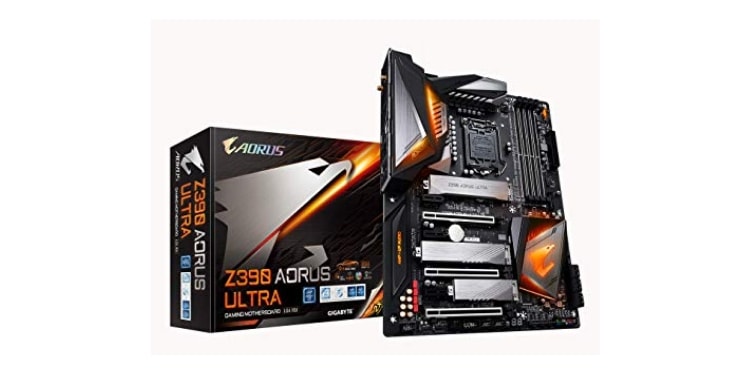
- Form Factor: ATX
- Socket type: LGA 1151
- Chipset: Intel Z390
- Memory: (4) DIMM, 64GB, DDR4-4266
- PCIe slots: x16, x16 (x8), x16 (x4), (3) x1
- USB ports: (10) rear IO, (7) internal
- Storage: (3) M.2, (6) SATA
- Plethora of features
- LED headers
- Over the top
When it comes to Intel motherboards, it doesn’t get much better than this. The Gigabyte Z390 AORUS Ultra is one of the best gaming motherboards on the market today, hands down. As you can see from the motherboard’s spec list, this board is packed with ports and features. It even has LED headers and an LED strip included for added bling.
Overclocking is easy with this motherboard’s overclocker friendly BIOS. Thanks to this motherboard’s wide range of support and extra features, it would be best used in a mid to high-end gaming PC.
If you’re balling on a budget, you’d be better off buying a cheaper board – you won’t use half of this board’s capability if you’re building a cheap gaming PC.
2. Gigabyte AB350-Gaming 3
Best AM4 motherboard
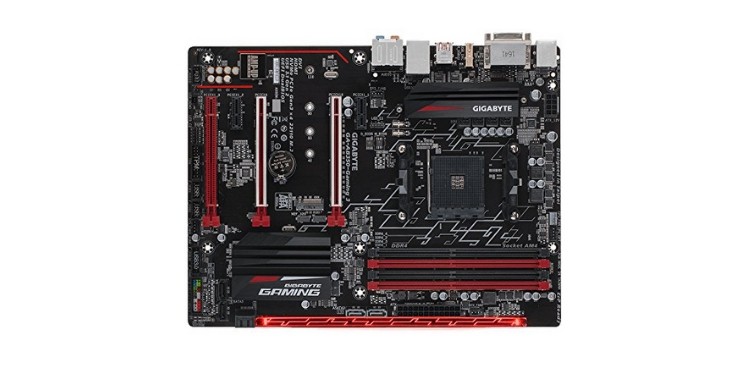
- Form Factor: ATX
- Socket type: AM4
- Chipset: AMD B350
- Memory: (4) DIMM, 64GB, DDR4-3200
- PCIe slots: x16, x16 (x4), (2) x1
- USB ports: 7 (rear) 5 (internal)
- Storage: (6) SATA
- Cheap
- Capable
- Overclockable
- Runs a bit hot
The Ryzen 5 2600 is one of the best gaming CPUs on the market right now, especially amongst other AMD options. Considering its mid-range price tag, it would be senseless to spend more than ~$100 on a motherboard.
That’s why we chose the Gigabyte AB350-Gaming 3 as the best AM4 gaming motherboard. You may have been expecting a more expensive X470 motherboard, for example, but that would’ve been overkill.
This motherboard is cheap, reliable, overclocker friendly, and has plenty of RAM slots – it’s everything the average gamer would need for a great price. You can’t go wrong with this AM4 motherboard!
3. MSI Arsenal Z270 Gaming Plus
Best LGA 1151 motherboard
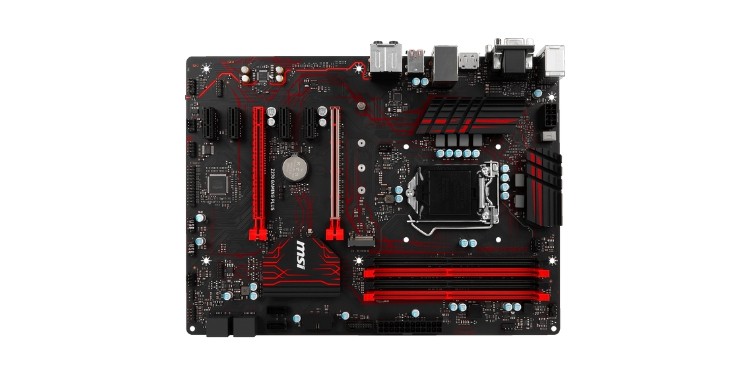
- Form factor: ATX
- Socket type: LGA 1151
- Chipset: Intel Z270
- Memory: (4) DIMM, 64GB, DDR4-3800
- PCIe slots: x16, x16 (x4), (4) x1
- USB ports: 6 rear, 8 internal
- Storage: (1) M.2, (6) SATA
- Price
- High speed RAM
- Price
Although Intel’s previous generation chipset isn’t the newest on the market, you can definitely save some money by opting to stick with Z270. Besides, it’s reliable and battle tested.
Despite its modest price, this board offers just about all of the features you’d want on a mid-range motherboard. Moreover, its build quality is impeccable.
Unfortunately, this motherboard’s Realtek ALC892 audio codec is terribly old – five years old, to be exact. MSI’s codec implementation makes up for the five year technology gap, so it’s not the end of the world, but it could have been better.
If you’re an audiophile, look elsewhere. Otherwise, this motherboard really packs a punch for a modest price.
4. MSI X299 Gaming Pro Carbon AC
Best ATX Motherboard
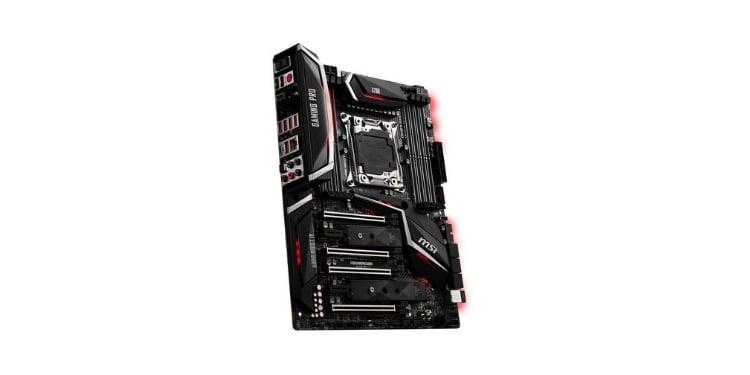
- Form factor: ATX
- Socket type: LGA 2066
- Chipset: Intel X299
- Memory: (8) DIMM, 128GB, DDR4-4000
- PCIe slots: (2) x16, x16 (x8), x16 (x4), (2) x1
- USB ports: (9) rear, (9) internal
- Storage: (2) M.2, (1) U.2, (1) M.2 Key-E, (8) SATA
- Amazing features
- Easy overclocking
- Modest HEDT price
- Not the fastest X299 model
If you’re searching for an HEDT (High-End Desktop) X299 motherboard, look no further. The MSI X299 Gaming Pro Carbon AC is one of the best ATX motherboards on the market.
Obviously, this motherboard should not be paired with an Intel-i3 and 8GB of RAM. This thing is for elite builds with loads of RAM, a top-tier i7 or i9 CPU, and several graphics cards running in SLI. This high end board is packed with features, ports, DIMM slots, and PCI slots.
Overclocking performance is solid, memory support is on par with other boards in this price range, and it has plenty of fast storage options and USB connections. There are other boards on the market with faster speeds and crazy extra features such as 10G Ethernet controllers, and maybe a third M.2 slot.
This board doesn’t sport any of those added extras, but it does have a much lower price tag than others in its weight class. That being said, unless you plan on using its still large assortment of features, there’s no sense in spending the extra money. Still, there’s no denying that this motherboard is made for elite builds and works well in them.
5. ASUS ROG Maximus X Hero Wi-Fi AC
Best Z370 motherboard for gaming
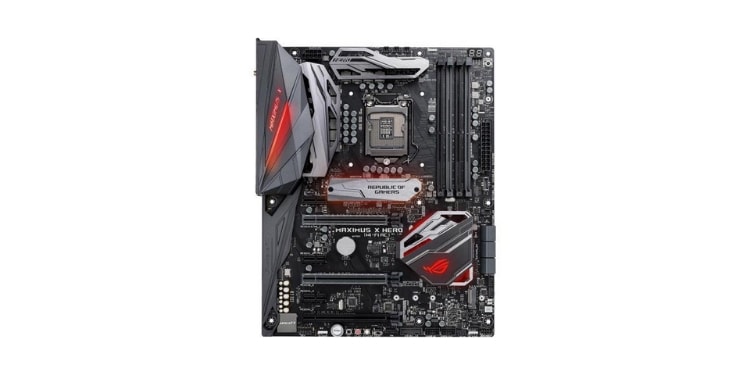
- Form factor: ATX
- Socket type: LGA 1151
- Chipset: Intel Z370
- Memory: (4) DIMM, 64GB, DDR4-4133
- PCIe slots: (2) x16 (x16 or dual x8), x16 (x4), (3) x1
- USB ports: 8 rear, 7 internal
- Storage: (2) M.2, (6) SATA
- Fantastic CPU/RAM overclocking
- Modest price
- Could use additional M.2
When building a Coffee Lake gaming PC, it would be hard to justify buying a board that’s more expensive than this one because it can’t push your rig much further. It has all of the features you’d expect from a high end board, and, fortunately enough, it’s not overly expensive.
The ASUS ROG Maximus X Hero managed to overclock a water-cooled i7-8700K to 5.1 GHz without much issue and only minor voltage adjustments.
Likewise, overclocking memory is painless, only requiring quick and minor adjustments. Performance is equally impressive across the board– please pardon the pun.
Lastly, the board has plenty of physical controls mounted on the board, such as a reset switch and a power button, a POST code display, a memory reset button, and a clear BIOS switch.
6. ASUS Prime X470-Pro
Best ASUS motherboard
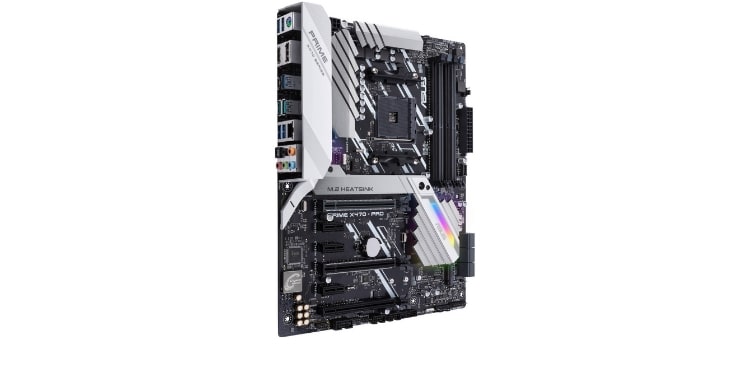
- Form factor: ATX
- Socket type: AM4
- Chipset: AMD X470
- Memory: (4) DIMM, 64GB, DDR4-3600
- PCIe slots: (2) x16 (x16 or dual x8), x16 (x8), x16 (x4), (3) x1
- USB ports: 8 rear, 6 internal
- Storage: (3) M.2, (6) SATA
- Features
- Next-gen connectivity
ASUS is a reputable manufacturer in the PC building arena, and their motherboards are no exception. This award-winning motherboard features 5-way optimization, allowing you to tune your entire PC at one time. This feature is great for easy overclocks and maintaining stable system temperatures.
The Prime X470-PRO also has fantastic cooling options, including comprehensive fan controls thanks to ASUS’ Fan Xpert 4 software. It even has an M.2 heatsink with an ultra-efficient design that reduces M.2 SSD temps by almost 20° C.
From an aesthetics standpoint, this board lives up to expectations. It has an awesome RGB ecosystem with onboard LED lighting controls. It’s an awesome ATX board with loads of nice features, all for a reasonable price.
7. ASUS ROG Strix Z390-I Gaming
Best Mini-ITX Motherboard
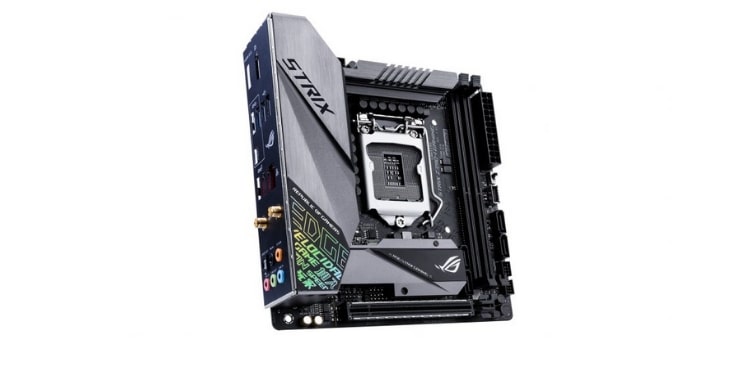
- Form factor: Mini-ITX
- Socket type: LGA 1151
- Chipset: Intel Z390
- Memory: (2) DIMM, 32GB, DDR4-4500
- PCIe slots: (1) x16
- USB ports: (7) rear, (1) front IO, (4) internal
- Storage: (2) M.2, (4) SATA
- Performance
- Dual M.2 slot
- I/O shield is bulky
This motherboard is considerably smaller than others on this list due to its Mini-ITX form factor, but it still packs a punch. The ROG Strix Z390-I Gaming edition (it’s literally a gaming PC motherboard) offers stellar performance and value for the money making it a good gaming motherboard no matter your setup.
It can easily achieve stable 5GHz overclocks with several different memory speeds, including 3600 MHz. Despite its tiny form factor, this motherboard isn’t anything short of awesome. It has several Gen 3 M.2 slots, Intel v219 Ethernet, fast Wi-Fi, and a great audio codec for crystal clear sound quality.
Consider mounting it in a Micro-ATX or Mini-ITX case as well. Just be sure to install one of the bottom-mounted M.2 slots before the motherboard, or you’ll have a headache later on down the line.
8. Gigabyte Z390 UD
Best budget gaming motherboard
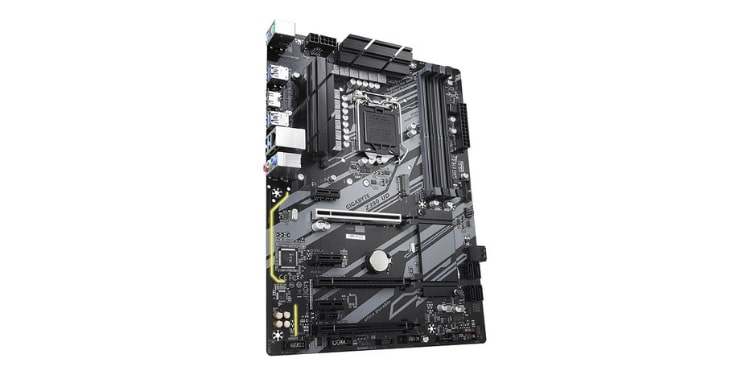
- Form factor: ATX
- Socket type: LGA 1151
- Chipset: Intel Z390
- Memory: (4) DIMM, 128GB, DDR4-4266
- PCIe slots: (1) x16, (2) x16 (x4), (3) x1
- USB ports: (6) rear, (2) internal
- Storage: (6) SATA
- Budget
- Reliable
- Low on features
At the end of the day, most people don’t need a lot of crazy features for their motherboard. As long as your CPU is compatible, you have enough storage options, and proper RAM support, a cheap motherboard will do the trick.
With that being said, it’s safe to say the Z390 UD is one of the best motherboards out there when you’re on a budget. It gets the job done for a low price– and that’s exactly what you should be after when building a budget gaming PC.
This motherboard doesn’t have a bunch of fancy bells and whistles, but despite being a cheap gaming motherboard, it is still a good gaming motherboard because it is reliable and boasts impressive performance given its low price. You’re still getting all of the necessary features that Z390 offers without some of the more expensive extras like SLI support.
How to Pick the Best Gaming Motherboard for Your Needs
Trying to find the best motherboard for gaming is hard and choosing a motherboard is important– after all, it holds your system together.
Let me explain: your CPU, GPU, RAM, hard drives, optical drives, case fans, and everything else in your PC connects to your motherboard.
If you don’t have the right socket type, your CPU won’t fit; if you don’t have the right chipset, you won’t be able to overclock; if you don’t have enough SATA connections, you won’t be able to hook up all of your drives.
As you can see, you have to plan well before you buy your motherboard.
However, just because your motherboard is important, doesn’t mean it has to be expensive. In fact, unless you’re building an elite gaming PC, you won’t have to spend but maybe $150- $100 on your motherboard because it won’t be loaded down with a lot of features you’ll never use.
Form Factor
There are several different motherboard form factors out there. ATX is the standard, but Micro-ATX and Mini-ITX boards are becoming more popular. There is also the slightly larger E-ATX (Extended ATX).
Since form factor literally refers to the size, it is going to restrict the types of cases you can use your motherboard in; the larger the board, the larger the case needs to be to fit it. As such, you should always take a look at the motherboard form factor.
When you’re choosing which size is best for you, think about the components you’ll be using. If you’re going to rock a bunch of RAM, a big water cooler, and several GPUs, you’re going to need a bigger board. On the flip side, if you were wanting to make a smaller PC, then you will want an ITX board.
ATX should be fine for most people, and it’s what I’d recommend for beginners as they’re the easiest to work with.
Socket Type
This one is pretty important. Before you choose your motherboard, select a CPU. Different CPUs have different socket types based on the CPU architecture and its manufacturer. After you pick your CPU, you’ll have to pick a motherboard with a compatible socket type.
For instance, you can’t use an Intel motherboard with an AMD CPU.
Chipset
Different motherboard chipsets have different capabilities. Chipsets actually do a lot behind the scenes, but we’re only going to be talking about overclocking here due to the scope of this beginner’s guide.
When choosing your CPU, you should have decided whether or not you wanted to overclock.
If no, then this is simple. Just buy a cheaper chipset that doesn’t support overclocking because you won’t need it.
If yes, then it’s actually still relatively simple: choose a chipset that supports overclocking. Keep in mind that some chipsets are better for overclocking than others – that is to say, they can achieve higher frequencies, and they’re more stable. You’ll have to do your research here.
Ports/Connectors
Lastly, you’ll want to make sure your motherboard has enough DIMM slots, PCI slots, and other connectors for everything in your PC. Check the number of SATA cable connectors, PCI slots, and DIMM slots for RAM. Also, make note of the supported RAM frequencies.
Four DIMM slots should be sufficient for most people – in fact, my motherboard only has two DIMM slots, and I have two 4GB sticks installed for a total of 8GB.
If you choose to buy a motherboard with only two DIMM slots, think about upgradeability. If your motherboard had four DIMM slots, for instance, and you bought two 4GB sticks now, you could still add two more 4GB sticks in the future for a total of 16GB.
Conversely, if you only have two DIMM slots and you want to upgrade to 16GB later on, you’ll have to replace the two existing 4GB sticks with two 8GB sticks.
The number of PCI slots on your board and their type should be determined by the number of graphics cards you’re going to use, in addition to any WiFi or sound cards, M.2 SSDs, etc.
You should also pay close attention to the number of USB ports, both internal and external, in addition to the number of fan headers, display ports, etc.
BIOS
For more info on BIOS, check out this short video. If you’re going to be tinkering around a lot– like overclocking– then you will also want to be knowledgeable about the BIOS your motherboard comes with. Some BIOS need to be updated on older motherboards before they’ll be compatible with newer CPUs.
Make sure your BIOS doesn’t need to be updated beforehand– otherwise, you may not be able to use your CPU unless you have an older, compatible CPU to update your BIOS.
In particular, you might want to be aware of this for AMD motherboards/processors since they have used the same socket for the past couple generations (Intel has traditionally changed their sockets every generation).
Once you’ve found a motherboard that meets all of your criteria, you’re good to go!
